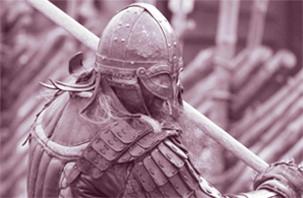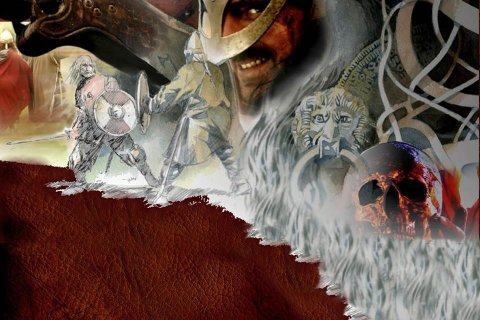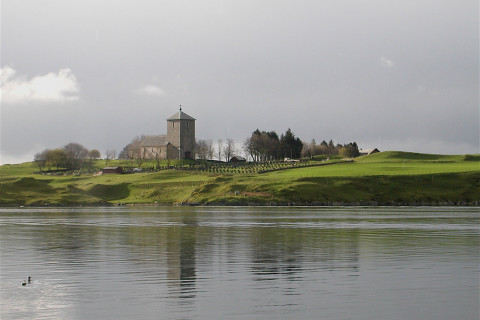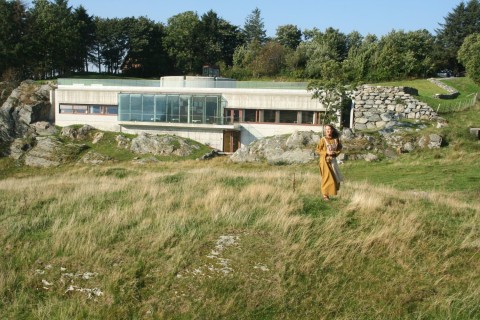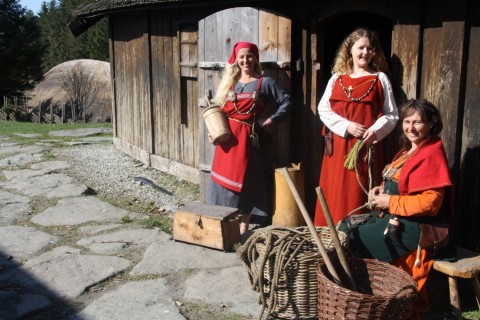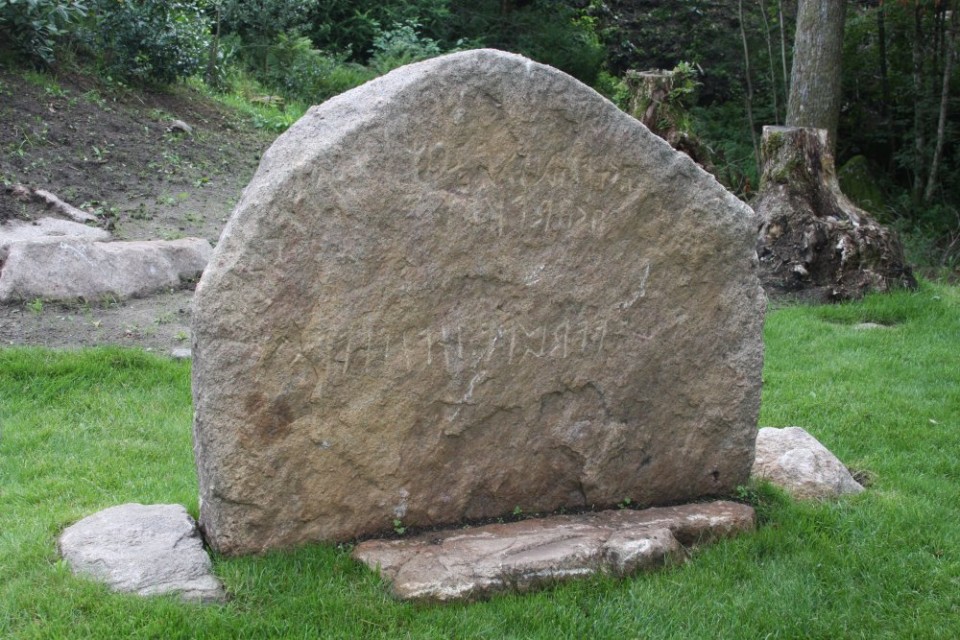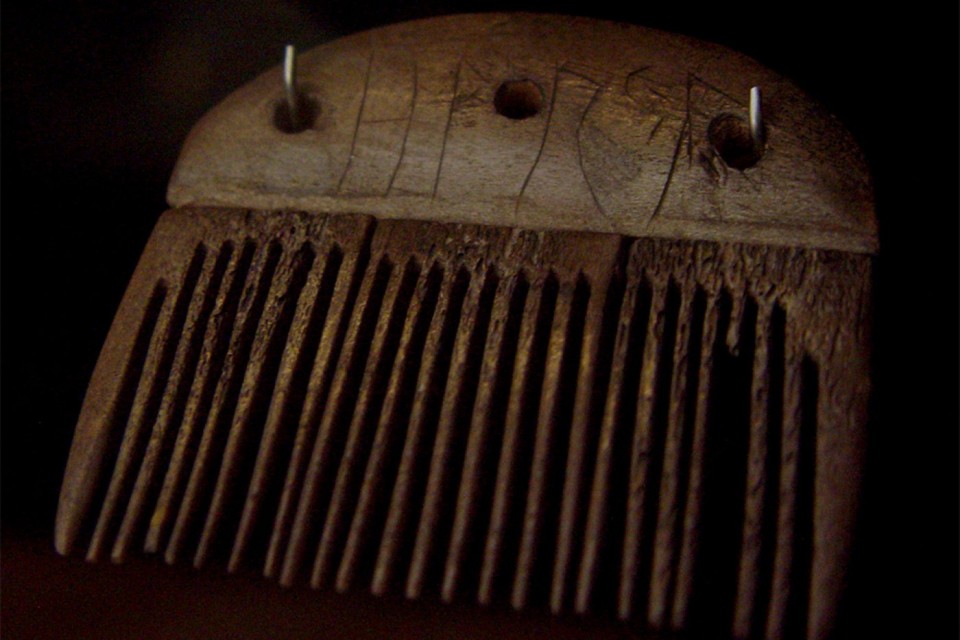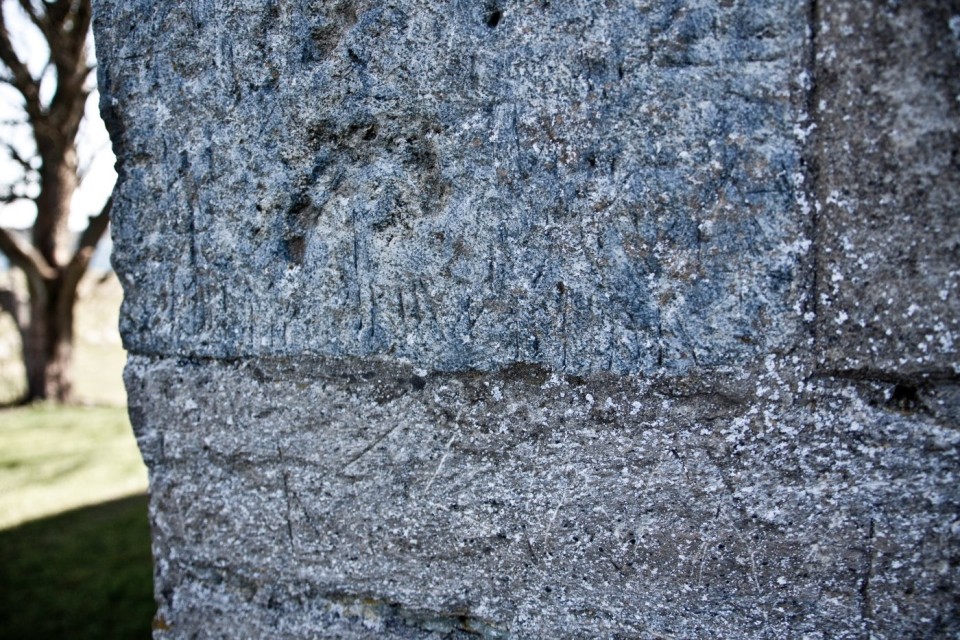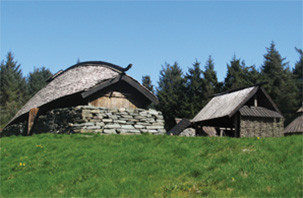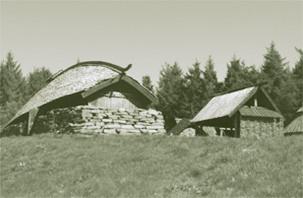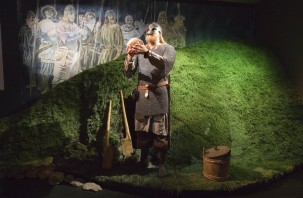Runes and magic
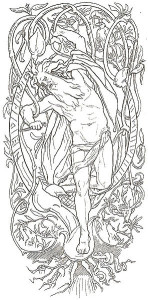
Odin sacrifices himself on the world tree Yggdrasil and discovers the runes .(Ill. Lorenz Frølich, 1895)
Text Marit Synnøve Vea
RUNES
Runes are woven into Norse religion and are closely associated with Norse magic (seiðr) and skaldic poetry. The runes were not invented. The old poem Hávamál explains that Odin discovered the runes when he hung himself from the world tree Yggdrasil in order to learn wisdom. He hung on the wind-blown tree for nine nights and days. Just as he was about to die, he found the runes, grabbed them and earned his life.
A more prosaic explanation is that the runes were developed in the firsth century AD, possibly inspired by the Latin alphabet. Although used by all Germanic peoples, most of them, however, are discovered in Scandinavia. Runes have a form such that they are easy to carve into a hard material. Note that one does not write but rather carves a rune.
Runes were carved on weapons, tools, jewellery, amulets, bones, pieces of wood, memorial stones, church walls etc.
Sometimes the runic inscription is read from left to right, sometimes from right to left.
Runes constitute contemporary documentation, but it can be difficult to decipher the runes and there are often several interpretations of an inscription.
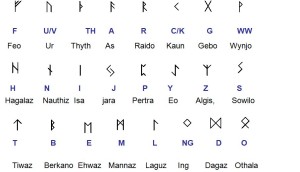
The elder Futhark
THERE ARE SEVERAL RUNIC ALPHABETS
The two main types of runic alphabet are called the elder Futhark and the younger Futhark after the sequence of the first six runic letters. The runes of the Middle Ages are relatively similar to the younger Futhark, but are characterised by pricks that shall differentiate between individual sounds such, for example, as P and D.
In addition, there is a sequence of local variants. Runic script existed simultaneously with the Latin alphabet and was in use up the 1500s. In Dalarne in Sweden, a particular type of runic script was in use up until approximately 1900.
The elder Futhark: 24 characters. These were in use from approx. 100 to 800 AD.
The younger Futhark: 16 characters. These were in use from approx. 800 AD to 1100 AD.
Medieval runes: 23 runes. Used from approx. 1100 to 1500 AD.

Two variations of the younger Futhark.
RUNES CAN BE BOTH MAGIC SYMBOLS AND ALPHABETIC LETTERS
Each runic character represents a «letter» such that they can be set together to form a word. The runes are also magical symbols, and each runic character has its own name and symbolic meaning.
Example:
X = g. This rune bears the name gifa and carries the symbolic meaning of gift/partnership. This character carries references that relate to generosity and relations between people.
I = i. This rune is named is and has the symbolic meaning of ice/standstill, which signifies a static situation.
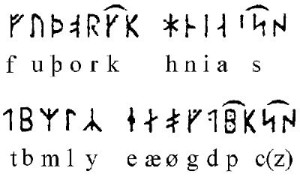
Medieval runes
RUNES USED AS LETTERS
Some examples:
Runes carved in wood
The word litiluism is carved on a wooden rod, perhaps part of an oar, in the Oseberg Ship. This is interpreted as meaning “Man knows little”
Carved on a bucket found in the Oseberg Ship are the words asikriR which translates as “Sigrid owns”. Was Sigrid the name of one of the women buried in the Oseberg ship?
An inscription found in Gol Stave Church, Bygdøy says: Kyss á mik, þvíat ek erfiða. = “Kiss me because I am troubled”.
At Bryggen in Bergen, a series of runic inscriptions were discovered that provide insight into the daily life of people in the Middle Ages.
Some examples:
Romantic messages:
On a vertebral of a cattle this request is carved: kyss mik. “Kiss me.”
Another inscription says:
Óst min, kyss mik. “My love, kiss me.”
Love poetry
This love poem was inscribed on a square-edged rune stick:
How I love another man’s wife
the vast mountains will begin to sway before I’ll forget her.
Eminent woman, we love each other so that the earth bursts apart.
Before I discard the wise woman, the raven shall
be white as the snow lying on the mountains.
Another rune stick has this inscription:
Remember me,
I remember you.
Love me,
I love you.
Runes about voyages:
Carved on a piece of wood: Hér ferr Hafdjarfr/hafdjarfr. “Here sails Hafdjarfr/the seabold.”
Runes used in mercantile activities.
A rune stick tells the following: «Torkel Mintmaster is sending you pepper».
Gossip and boasting:
A man in Bergen put about some gossip, or perhaps he was just boasting, when he wrote: Ingibjörg unni mér þá er ek var í Stafangri. = Ingebjørg loved me when I was in Stavanger.
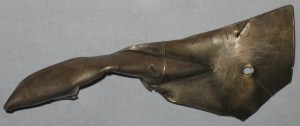
Shield-handle mount of silver from Illerup, approximately 250 AD, with the runic inscription Laguþewa / LaguþewaR. The personal name can mean sea-servant or law-servant. (Photo Nationalmuseets database, danske runeindskrifter)
A wife’s message:
To a man who possibly used a little too much time in the pub: Gyða segir at þú gakk heim. = Gyda tells you to go home.
Runes carved into metal
A bracteate of gold from the first half of 500’s, found in Sandnes in Rogaland, has an image of a human head and an inscription with the runes meaning T A U. Probably the bracteate was carried around the neck like a good luck charm.
The following is inscribed on a silver neck ring dating from around 1000 AD found in Senja in Troms County: Fórum drengja Fríslands á vit ok vígs fótum vér skiptum. This translates as: “We travelled to meet the valiant men of Frisia (and) we divided the spoils of the fight.”
Runes used on memorial stones
The runes on memorial stones were used in order to pay tribute to deceased persons, to show who had erected a bridge, who retained power in a certain area etc.
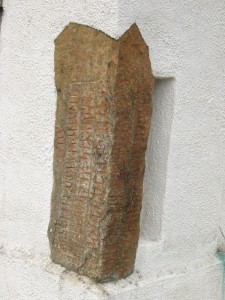
One of three runestones used as building material in Hällestad church. (Photo Wikimedia Commons)
During the 5th century, a grieving father in Rogaland County carved the following words into a stone in order commemorate his son: «Haduleik rests here. I, Hagustald, buried my son”.
In the late 10th Century, a rune stone was erected in Hällestad, Sweden in memory of a fallen warrior:
Áskell placed this stone in memory of Tóki Gormr’s son, to him a faithful lord.
He did not flee at Uppsala.
Valiant men placed
in memory of their brother
the stone on the hill,
steadied by runes.
They went closest to Gormr’s Tóki.
Around 1050 a mother let these words be carved in memory of her daugther on the Dynnastone, Oppland Norway; “Gunnvor, Thrydrikr’s daughter, made the bridge in memory of her daughter Astridr. She was the handiest maiden in Hadeland.”
RUNES USED AS MAGICAL SYMBOLS
The word rune means “secret”, “mystery”. In the sagas we learn that the word rune is not just used about carved signs, but also for certain songs, magical formulas, secret skills, and for secrets hidden in skaldic poetry.
Runic magic was used to foretell the future; as a form of protection; to cast spells; to cure illness; to bestow love etc.

Fibula with the runic inscription “alugod” followed by a swastika. From the third century. Found in Værløse, Danmark. Housed at the National Museum of Denmark. (Photo Bloodofox. Wikimedia Commons)
It could, however, be fairly risky if runes were carved by unskilled persons. In Egil’s saga, we learn that a young girl has become ill because an infatuated suitor has carved runes on a whalebone in order to awaken her love. Egil finds the runes under the girl’s bed. He scrapes the signs away and burns the whalebone and then carves new runes which he places under the girl’s pillow, which lead her to make a recovery.
Egil then gives this warning:
Runes none should grave ever
Who knows not to read them;
Of dark spell full many
The meaning may miss.
Ten spell-words writ wrongly
On whale-bone were graven:
Whence to leek-tending maiden,
Long sorrow and pain.
SAGAS AND POEMS THAT TELL OF MAGICAL RUNES
In the poem known as Rigstula we learn that the youngest of Jarl’s sons can only be called «king» when he has become a Rune Master and has learned runic magic that heals wounds, calms cravings, quenches flames, pacifies storms, and allows him to understand birdsong.
In the poem Sigrdrífumál (sayings of the victory-bringer), we learn how Sigurd Fåvnesbane comes to the female warrior Sigrdrifa and asks her to dispense her wisdom to him. She then recites this prayer:

Copies of the Golden Horns of Gallehus in Southern Jutland, Denmak. The horns date to the early 5th century. One of the horns has a runic inscription interpreted as : ” I Hlewagastiz Holtijaz made the horn”. It is uncertain if they originally were used as drinking-horns or lures. (Photo Malene Thyssen, Wikimedia Commons)
Hail, day!
Hail, sons of day!
And night and her daughter now!
Look on us here
with loving eyes,
That waiting we victory win.
Hail to the gods!
Ye goddesses, hail,
And all the generous earth!
Give to us wisdom
and goodly speech,
And healing hands, life-long.
In the prayer we hear which characteristics she prays for Sigurd to be endowed with. These are: wisdom, eloquence, the ability to create poetry, and to be able to heal and cure illness. She then gives him a drink to toast with – a horn filled with mead, the drink of skaldic poetry – and teaches him runic magic.
Sigrdrifa tells of victory-runes (sigrúnar) that are to be carved onto various parts of a sword; of wave-runes (brimrúnar) that are to be carved into the side of a ship and onto oars in order to protect the crew; birth-runes (bjargrúnar) that shall be of assistance during childbirth such that new-born infants survive. Sigrdrifa also tells of branch-runes/life-runes (limrúnar) that can treat wounds and illness; of ale-runes (ölrúnar) that shall protect one against betrayal; of speech-runes (málrúnar) that foster eloquence and confidence; of thaught-runes (hugrúnar) that bestow wisdom.
CARVING MAGICAL INSCRIPTIONS
In the available archaeological material we can find individual runes that are carved into weapons and jewellery. As an example, the Tiwaz rune (ᛏ) stands for victory and the Algiz rune (ᛉ) stands for protection.
We also find that runic formulas are carved as magical words or as extended invocations, without it being always so straightforward to interpret these formulae.
Runic incantations must have been in use well into the age of Christianity. Among other items discovered at Bryggen in Bergen is a six-sided rune stick from the later part of the 1300s where Odin is referred to in the following way:
I conjure you, Odin, with (paganism), the largest among devils.
Go with it. Tell me the name of the man who stole. For Christianity.
Tell me now (your) lewdness. One mocks I, (secondly) is taunting me.
Tell me, Odin! Now (amounts of devils?) conjured up with all (paganism).
You should now obtain me the name of whoever stole. (Amen.)
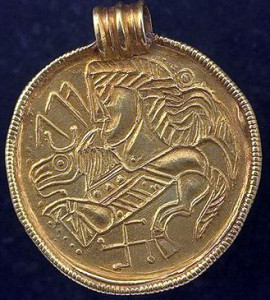
Migration period golden bracteate witht he runic inscription “alu” and a swastika. From Gotland, Sweden.. (Photo Sigune, Wikimedia Commons)
Simple words
One of the words that must have had a special meaning is alu, which is found on amulets, bracteates, and on stones. Among others, it has been found on a bronze plate discovered at Fosse in Rogaland County. Some sources mean that alu is a magic spell formula that shall keep evil spirits at bay, while others mean that alu means ale, a drink that is often used in conjunction with rituals.
Composite words
At Meland in Nordhordaland County, a scraping knife has been discovered that is inscribed with the following: lina laukaR f. This translates as flax – onien – F . Flax and onions were used in fertility rituals. We are aware of this from, among others, the story of the sacrifice in Volsetotten. The F-rune (Fehu) that comes last, has the symbolic meaning – livestock or riches..
Several sentences
The Eggja Stone: The longest inscription that exists in Norway featuring runes from the elder Futhark period is to be found on the Eggja Stone that dates from around 600 AD. The stone slab lay on top of a grave with the rune side facing downwards. Several interpretations exist.
One suggested translation:
Panel 1:
No sun sought and no sax stone scarred
No man laid it nude as the niþ runs
No bewildered men lay it aside

Part of the inscription on the Eggja stone. The stone was found with the written side downwards over a man’s grave. (Photo Arild Nybø)
Panel 2:
Hither stone the man stained with corpse-sea, made thus oarpins in the bearing-worn boat
Whom as came harrier-god here to goð’s land?
Fishlike, out of river-fear swimming, as bird, our of f(?) crowing
Panel 3:
Alu (Protection against the wrong-doer)
The Hogganvik stone: A mystical inscription found on a stone in 2009, Mandal, Norway. It was lying face down, but was probably erected as a memorial stone sometimes around 400 AD. Runologist James E. Knirk has translated the inscription like this:
Skelba-þewaz’s [“Shaking-servant’s” (personal name)] stone
aaasrpkf (letters used as an incantation).
I [=the rune carver] [am called] Naudigastiz [=”Need-guest” (personal name)]; (name of the Runecarver)
I, [nicknamed] the Wolverine.
aarpaa (letters used as an incantation)? Within/From within the ? wheel-nave/?cabin-corner [or: ?needle]. (Place)
RUNES ON A NITHING POLE
Egil Skallagrimsson carved runes on a nithing pole that he had erected against Eirik Bloodaxe. A nithing pole is a horse’s head that can cast shame and curses. Egil’s saga tells about this:
(…) He took in his hand a hazel-pole, and went to a rocky eminence that looked inward to the mainland. Then he took a horse’s head and fixed it on the pole. After that, in solemn form of curse, he thus spoke: ‘Here set I up a curse-pole, and this curse I turn on king Eric and queen Gunnhilda. Here he turned the horse’s head landwards. This curse I turn also on the guardian-spirits who dwell in this land, that they may all wander astray, nor reach or find their home till they have driven out of the land king Eric and Gunnhilda.
This spoken, he planted the pole down in a rift of the rock, and let it stand there. The horse’s head he turned inwards to the mainland; but on the pole he cut runes, expressing the whole form of curse.
PROPHETIC RUNES
In the sagas we learn that runes were used to foretell the future. We hear of rune casting and of wooden chips used for magical or ritual purposes, but it is unclear how these rituals were enacted. We can possibly obtain one indication from the Roman historian, Tacitus (approx. 100 AD) who said of the Germanic people that they maintain the custom of forewarning and prophecy by casting lots/casting sticks containing different signs.
They attach the highest importance to the taking of auspices and casting lots. Their usual procedure with the lot is simple. They cut off a branch from a nut-bearing tree and slice it into strips these they mark with different signs and throw them at random onto a white cloth. Then the state’s priest, if it is an official consultation, or the father of the family, in a private one, offers prayer to the gods and looking up towards heaven picks up three strips, one at a time, and, according to which sign they have previously been marked with, makes his interpretation. If the lots forbid an undertaking, there is no deliberation that day about the matter in question. If they allow it, further confirmation is required by taking auspices. (Extract from Tacitus’ Germania)
Blótspánn – (wooden chips cast in blood)
Ancient sagas and poems tell that wooden chips could be cast in bowls containing blood from sacrificed animals. This ritual was performed in order to obtain warnings and to see into the future. The poem known as Lay of Hymir mentions twigs and blood in the same verse. This can mean that wooden chips or twigs were carved with runes prior to being cast into the bowl.
Of old the gods
made feast together,
And drink they sought
ere sated they were;
Twigs they shook,
and blood they tried:
Rich fare in Ægir’s
hall they found
About seiðr (Norse magic) and volvas
See Viking women
See also:
Runer – Store Norske Leksikon
Samnordisk runtextdatabas
Norges Indskrifter med de ældre Runer. (Sophus Bugge, 1891-1903 )
Norges innskrifter med de yngre runer (Magnus Olsen 1954)
Danske runeindskrifter, Nationalmuseet
Arild Hauges Runer
Back

